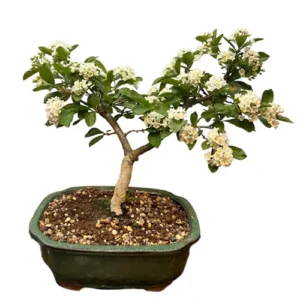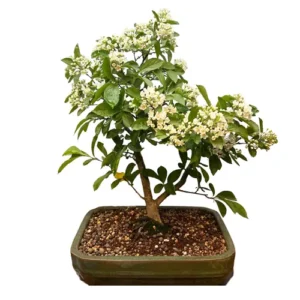Pseudocydonia sinensis
Chinese Quince Bonsai
Native to China, this deciduous has large pink leaves that turn a vibrant orange in the Autumn. Far from the simplest bonsai to keep they are sought after for their usual fruit. Its bark has a peeling, flaking quality.
Chinese Quince Bonsai Care Tips
Placement
Across the growing season, Chinese Quince can be kept in full sun and ideally an airy location. It is not a solidly hardy species so requires winter protection. Planted in a pot in requires some frost.
Watering
During the summer when your Chinese Quince is producing its flowers, it requires generously. This goes for throughout the growing season to ensure the rootball never dries out. In the winter, keep the soil moist.
Feeding & Fertilising
Feed only once the fruit has set. During the growing season, use a solid organic fertiliser once a month or a liquid feed weekly.
Pruning & Wiring
Pruning your bonsai is important not only to create or maintain an aesthetic style but to also ensure optimal health. New shoots should not be trimmed until flowers are visible. When fruits begin to show remove most as leaving all will likely weaken the branches and take most of the tree’s energy. After flowering, trim back new shoots to one or two leaves after they have grown. On younger trees, remove flower buds where you want the trunk and branch structure to develop. Winter dormancy is the best time for hard pruning.
We recommend using wires with a thickness that matches the thickness of the branch: if the wire you choose is too thick you will damage the bark. If it is too thin, it won’t be effective.
Repotting
Repotting your tree is an important way to provide a fresh and suitable soil mix and ensure appropriate root health. Repot your Chinese Quince every other year at the start of spring.
Trees that are ready for repotting will require root pruning, a suitable new pot and appropriate soil mix.
When repotting, do not cut back the root mass by a large amount, and choose a well-draining soil mix that has a neutral or slightly higher PH value of 5-6 but not over 7. We tend to use a mixture of different speciality bonsai soils on our trees. Every species is different so please contact us for free soil-mix advice or to take advantage of our repotting service.
Bonsai trees aren’t only magnificent additions to an indoor oasis, they are more than capable of standing out in any garden. Many Bonsai species are incredibly hardy and withstand nature’s colder and damper turns with aplomb making them worthwhile outdoor plants. We have an extensive library of care guides for outdoor bonsai trees. It’s not about selecting the perfect bonsai, it’s about selecting the perfect bonsai for you.
Chinese Quince Bonsai - Typical Queries
How to propagate Chinese Quince bonsai?
Chinese Quince needs propagating from seeds softwood cuttings or ai-layering. Softwood cuttings should be planted in Summer. Layers can be taken in the Autumn. Seeds should also be sown in the Autumn.
Do Chinese Quince bonsai get pests and diseases?
Chinese Quince can attract intruders including scale, weevils or aphids. It can also suffer from fire blight. Applying the correct insecticide is necessary in the event of an infection.
Can you keep a Chinese Quince bonsai indoors?
It is not advisable to keep a Chinese Quince bonsai indoors. This is a half-hardy deciduous species that thrives with exposure to the elements. Keeping indoors will likely hamper any opportunity for growth without a considerable and bespoke indoor set-up.





















